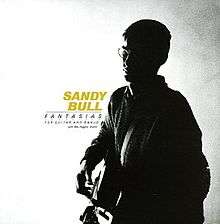Fantasias for Guitar and Banjo
Fantasias for Guitar and Banjo is the debut album of the folk guitarist Sandy Bull, released in 1963 through Vanguard Records.
| Fantasias for Guitar and Banjo | ||||
|---|---|---|---|---|
 | ||||
| Studio album by | ||||
| Released | August 1963 | |||
| Recorded | 1963 | |||
| Genre | Folk, American Primitivism | |||
| Length | 42:23 | |||
| Label | Vanguard | |||
| Sandy Bull chronology | ||||
| ||||
Recording
Bull recorded the album accompanied by Billy Higgins, a session jazz drummer who had previously appeared on early Ornette Coleman records.[1] Together they recorded three original pieces as well as interpretations of Carmina Burana Fantasy and Non nobis Domine.
Music
The highlight of Fantasias for Guitar and Banjo is usually considered to be its opener "Blend", a lengthy improvisational piece.[2] According to Bull, the ideas behind the piece originated from his admiration of Folkways Records, which documented ethnic music from across the world. He also claimed to being particularly inspired from hearing Ravi Shankar and Ali Akbar Khan in New York City.[3] "Blend" has been viewed as a "virtual travelogue of styles done in a then revolutionary modal tuning".[4] The tuning is in the key of B.[5]
Release and reception
| Review scores | |
|---|---|
| Source | Rating |
| AllMusic | |
Matthew Greenwald of AllMusic describes Fantasias for Guitar and Banjo as an "incredible debut" and lauds it for being well ahead of its time.[4] Writing in Crawdaddy in December 1966, Sandy Pearlman recognized the album as a work that presaged pop music's move toward raga rock. Pearlman said that, with Fantasias, Bull "became a leading innovator in the assimilation of Indian influences into a Western musical context".[6]
Author Kevin Fellezs views the album as a prime example of an "underacknowledged early fusion-world recording that remains musically compelling today".[1]
Track listing
| No. | Title | Writer(s) | Length |
|---|---|---|---|
| 1. | "Blend" | Bull | 22:00 |
| No. | Title | Writer(s) | Length |
|---|---|---|---|
| 1. | "Carmina Burana Fantasy" | Orff | 4:34 |
| 2. | "Non nobis Domine" | Byrd | 1:39 |
| 3. | "Little Maggie" | Bull | 4:09 |
| 4. | "Gospel Tune" | Bull | 10:01 |
Personnel
External links
- Fantasias For Guitar And Banjo at Discogs (list of releases)
References
- Fellezs, Kevin. Birds of Fire: Jazz, Rock, Funk, and the Creation of Fusion. Duke University Press. 2011. pg. 50. Retrieved August 11, 2012.
- Larkin, Colin. The Virgin Encyclopedia of Jazz. Virgin Books. 1999. pg. 135. Retrieved August 11, 2012.
- Leech, Jeanette. Seasons They Change: The Story of Acid and Psychedelic Folk. Jawbone Press. 2010. pg. 43. Retrieved August 11, 2012.
- Greenwald, Matthew. "Fantasias for Guitar & Banjo". Allmusic. Retrieved August 10, 2012.
- Williams, Paul. The Crawdaddy! Book: Writings (And Images) from the Magazine of Rock. Hal Leonard Corporation. 2002. pg. 102. Retrieved August 11, 2012.
- Pearlman, Sandy (December 1966). "Patterns and Sounds: The Uses of Raga in Rock". Crawdaddy. Available at pastemagazine.com (June 9, 2015). Retrieved July 3, 2017.